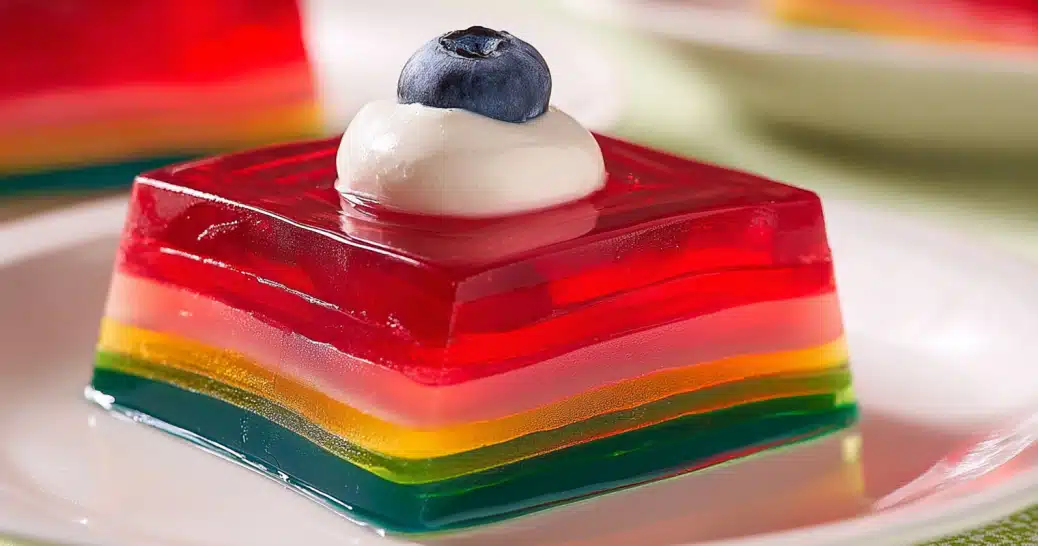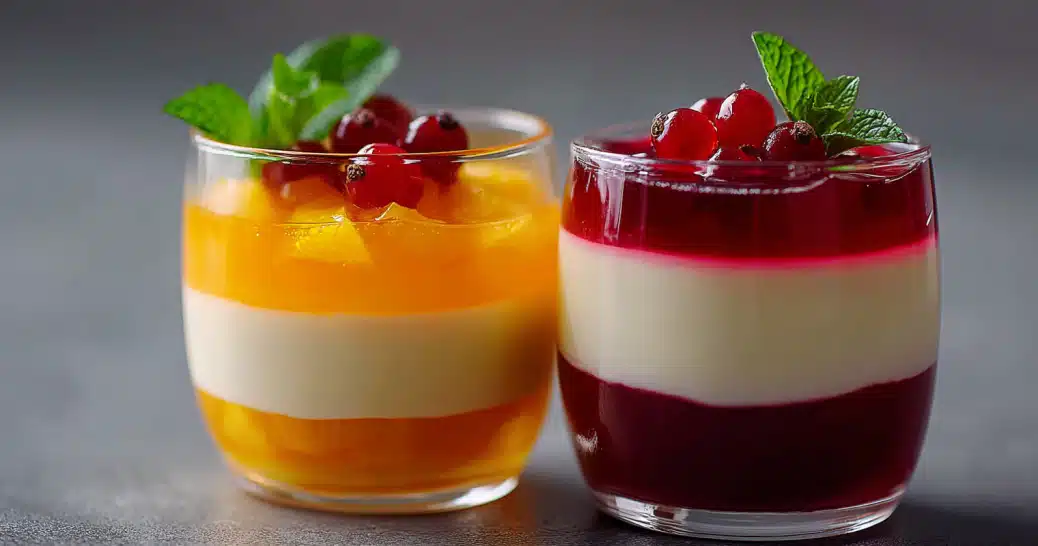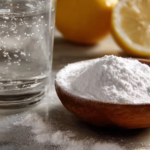When it comes to setting desserts, few ingredients spark as much debate as agar vs gelatin. Both are gelling agents that can transform liquids into delightful textures, yet they come from completely different sources. Whether you are crafting a smooth panna cotta, shaping vegan gummies, or experimenting with layered fruit jellies, choosing between agar and gelatin can make or break your recipe. In this guide, we explore how these two ingredients work, what sets them apart, and how to use them like a pro in both sweet and savory dishes. You will learn their origins, health benefits, substitution methods, and even how chefs around the world use them in creative ways.
Table of Contents
Understanding Agar and Gelatin
What is Gelatin?
Gelatin is a natural protein derived from animal collagen, typically extracted from the bones, skin, and connective tissues of pigs or cows. When dissolved in hot liquid and then cooled, it creates a soft, bouncy gel that gives structure to desserts like marshmallows, panna cotta, and gummy bears. Gelatin’s versatility has made it a staple in kitchens for centuries, and its unique texture delivers that signature melt-in-the-mouth sensation people love.
Different types of gelatin are available, including powdered and sheet forms. Their strength, known as bloom strength, determines how firm the final set will be. A higher bloom means a firmer gel, while a lower bloom creates a softer, creamier texture. Gelatin is not vegan or vegetarian, making it unsuitable for those avoiding animal products.
What is Agar-Agar?
Agar, often labeled as agar-agar, is a plant-based alternative made from red seaweed, particularly species from the Gracilaria and Gelidium families. Originating in Japan centuries ago, agar became a vital ingredient in Asian desserts long before its popularity spread to Western kitchens. Unlike gelatin, agar sets at room temperature and remains firm even in warm conditions, which makes it a favorite in tropical climates.
Agar has no flavor, sets clearly, and forms a much firmer texture than gelatin. It comes in several forms, including flakes, bars, and powder. The powdered version is the most concentrated and dissolves easily, making it ideal for precise recipes.
Here’s a quick comparison table for clarity:
| Feature | Gelatin | Agar-Agar |
|---|---|---|
| Source | Animal collagen | Red seaweed |
| Dietary type | Non-vegan | Vegan |
| Sets at | Cool temperature | Room temperature |
| Texture | Soft and elastic | Firm and brittle |
| Flavor | Neutral | Neutral to slight seaweed note |
| Heat stability | Low | High |
Origins and Traditional Uses
Gelatin’s origins trace back to the early 15th century in Europe, where it was first used in savory aspics and later in sweet confections. Over time, it became an essential ingredient in the creation of jellies, mousses, and marshmallows. In contrast, agar-agar has deep roots in Asian cuisine. In Japan, it is called “kanten” and has been used in traditional desserts like yokan, a sweet red bean jelly, for hundreds of years.
Today, both ingredients have found their way into modern kitchens across the world. Gelatin remains the top choice for creamy, delicate desserts, while agar serves as a go-to for vegan, vegetarian, and heat-stable recipes. As the demand for plant-based cooking grows, agar continues to gain recognition as a versatile and eco-friendly gelling agent.
Agar vs Gelatin – Key Differences
Chemical Structure and Source

The most fundamental difference between agar and gelatin lies in their origin and composition. Gelatin is an animal-derived protein obtained from collagen, the structural component that gives strength to animal skin, bones, and connective tissue. When heated in water, the collagen breaks down into gelatin molecules that trap liquid as they cool, creating a soft gel.
Agar, in contrast, is a plant-based polysaccharide extracted from red algae. It is composed mainly of agarose and agaropectin, both of which have unique gelling properties. Unlike gelatin, agar’s structure is carbohydrate-based, which means it does not contain any protein or collagen. This difference not only changes how each sets but also how they behave under heat and in various recipes.
For cooks and bakers, this chemical difference determines more than just dietary suitability. It affects how the gel forms, its strength, clarity, and even how it interacts with other ingredients such as acids, sugars, and fats.
Setting Temperature and Stability
Agar and gelatin respond to temperature in completely different ways. Gelatin dissolves in warm liquid and begins to set as it cools, typically between 59°F and 77°F (15°C–25°C). However, gelatin melts easily at around body temperature, which is why it provides that pleasant “melt-in-your-mouth” texture. The downside is that gelatin-based desserts can lose their structure in hot environments.
Agar behaves differently. It must be boiled to activate, usually at 212°F (100°C), and sets at about 95°F (35°C). Once set, agar remains firm even when exposed to warm conditions, staying solid up to 185°F (85°C). This makes agar an excellent choice for dishes that need to hold their shape at room temperature or for displays in warm kitchens.
Here’s a quick technical comparison:
| Property | Gelatin | Agar-Agar |
|---|---|---|
| Activation temperature | 104–113°F (40–45°C) | Must be boiled (212°F / 100°C) |
| Setting temperature | 59–77°F (15–25°C) | 86–104°F (30–40°C) |
| Melting point | ~77°F (25°C) | ~185°F (85°C) |
| Stability | Soft and melts easily | Very firm and heat-stable |
In short, gelatin creates soft, tender gels perfect for chilled desserts, while agar produces a firm structure that resists melting. If you need your dessert to stand up to warm weather or room temperature, agar is the clear winner.
Texture, Clarity, and Appearance
Texture plays a huge role in how desserts feel and look. Gelatin forms an elastic, silky gel that bends and wobbles. It melts on the tongue, creating a luxurious mouthfeel that people often associate with creamy panna cottas or fruit jellies.
Agar sets into a firmer, more brittle gel. Instead of wobbling, it holds sharp, clean edges. This makes it ideal for decorative layered desserts, jelly cubes, and precise pastry applications. While gelatin’s transparency is slightly superior, agar can appear a bit cloudy if not fully dissolved. To ensure a clear set, always boil agar thoroughly and strain it before use.
When it comes to appearance, both gels are colorless and flavorless, making them perfect blank canvases for flavoring and coloring. However, gelatin gives a slightly more glossy finish, while agar results in a matte, opaque look.
In practice, the choice between the two depends on the desired outcome. For creamy, delicate desserts that melt in the mouth, gelatin remains unmatched. For firm, structured, vegan, or heat-resistant recipes, agar-agar takes the lead.
How to Substitute Agar and Gelatin
Agar vs Gelatin Ratio in Recipes
When substituting agar for gelatin, it’s essential to remember that they don’t work on a one-to-one ratio. Agar is much more potent than gelatin, meaning you need less of it to achieve the same firmness. Generally, one teaspoon of agar powder can replace one tablespoon of gelatin powder, but the texture won’t be identical. Gelatin produces a soft, bouncy gel, while agar creates a firmer, more sliceable result.
If you’re experimenting with desserts, remember that agar vs gelatin conversions depend on your recipe type and the texture you want. For a pudding or panna cotta that’s soft and creamy, use about 1 teaspoon of agar powder for every 2 cups of liquid. For a firm jelly or layered dessert, increase it to 1½ to 2 teaspoons.
Here’s a quick guide for easy comparison:
| Desired Texture | Agar Powder | Gelatin Powder |
|---|---|---|
| Soft set (puddings, panna cotta) | 1 tsp per 2 cups | 2 tsp per 2 cups |
| Firm set (jellies, cubes) | 1½–2 tsp per 2 cups | 1 tbsp per 2 cups |
Step-by-Step Substitution Guide
Switching from gelatin to agar is simple once you know how each behaves. Unlike gelatin, agar needs heat to activate. Follow these steps for a perfect swap:
- Measure carefully. For every tablespoon of gelatin, use about one teaspoon of agar powder.
- Dissolve before heating. Mix agar powder with your liquid before turning on the heat to avoid lumps.
- Boil to activate. Bring the mixture to a full boil for one to two minutes while stirring. Agar will not set properly if it isn’t boiled.
- Pour and let it set. Once dissolved, pour into molds and allow it to cool. Agar sets quickly, even at room temperature, usually within 45–60 minutes.
This method ensures your agar-based desserts turn out smooth and firm without any gritty or grainy texture. Remember, gelatin simply blooms in warm liquid, while agar must be boiled to work.
Common Mistakes When Substituting
Even experienced cooks can run into trouble when substituting agar and gelatin. Below are common pitfalls and how to avoid them:
- Skipping the boil. Agar won’t set if it’s not fully boiled. Always bring the mixture to a simmer and stir until no particles remain.
- Overusing agar. Too much agar results in a rubbery or brittle texture. Stick to recommended ratios for the best balance.
- Combining with acidic ingredients too soon. If your recipe includes lemon juice, vinegar, or citrus, add them after boiling. Acids can weaken agar’s gelling power.
- Adding to dairy while hot. Hot agar can cause milk to curdle. Allow the agar mixture to cool slightly before combining with dairy-based mixtures.
Agar is fast-setting and forgiving when used correctly. Gelatin, however, offers more flexibility in creamy desserts. The choice between agar vs gelatin ultimately depends on the recipe’s purpose, the desired mouthfeel, and dietary needs.
A quick tip: If you prefer a soft texture similar to gelatin, slightly reduce the agar amount or add a bit more liquid. With practice, you’ll master the substitution and be able to customize the texture to perfection.
Health Benefits and Nutrition Comparison
Nutritional Breakdown per Tablespoon
The nutritional profile of agar vs gelatin differs significantly because one is plant-based and the other is animal-derived. Gelatin is high in protein and collagen, while agar provides fiber and trace minerals but contains no protein. These contrasting compositions make them suitable for different dietary goals.
Here’s a quick nutritional comparison per tablespoon:
| Nutrient | Gelatin | Agar-Agar |
|---|---|---|
| Calories | ~35 | ~10 |
| Protein | 9g | 0g |
| Fiber | 0g | 2g |
| Collagen | High | None |
| Fat | 0g | 0g |
| Vegan-friendly | No | Yes |
Gelatin is a rich source of amino acids like glycine and proline, both of which support joint health, skin elasticity, and muscle repair. On the other hand, agar provides a unique type of soluble fiber called agarose, known for promoting satiety and improving digestion.
For individuals looking to increase collagen intake naturally, gelatin is the clear winner. For vegans or anyone avoiding animal products, agar delivers valuable plant-based nutrition with almost no calories.
Collagen and Protein Content Differences
Collagen is a key component of animal tissues and plays an essential role in maintaining skin and joint health. Since gelatin is derived directly from collagen, it offers a bioavailable source of this protein. Many people use gelatin supplements to support healthy hair, nails, and skin, or to aid in post-exercise recovery.
Agar, being seaweed-based, contains no collagen or protein. However, its high fiber content can still contribute to digestive health by improving gut motility. The polysaccharides in agar can also act as prebiotics, feeding beneficial bacteria in the gut.
When comparing agar vs gelatin, the question isn’t which is healthier overall, but rather which aligns better with your nutritional goals. Gelatin supports collagen and protein needs, while agar fits plant-based, low-calorie, and high-fiber lifestyles.
Digestive and Dietary Advantages
Agar is often praised for its mild laxative effect, which comes from its natural fiber structure. It helps regulate bowel movements and can relieve occasional constipation without irritation. Agar also promotes fullness, making it helpful for weight management and portion control.
Gelatin, in contrast, supports gut integrity through collagen’s role in maintaining the stomach lining. It may help reduce symptoms of leaky gut and improve digestion. Some studies also suggest that gelatin aids in reducing inflammation and joint discomfort due to its amino acid profile.
From a dietary perspective, agar is naturally vegan, gluten-free, and hypoallergenic, which makes it suitable for a wide audience. Gelatin, however, is not vegan and can be unsuitable for those avoiding pork or beef products. For this reason, many home cooks and food manufacturers turn to agar to create vegan versions of popular desserts and snacks.
Summary of Health Impact
In short, both ingredients offer distinct health benefits. Gelatin excels in collagen production, protein intake, and joint support. Agar shines for digestive health, fiber content, and plant-based nutrition. Choosing between agar and gelatin depends on whether your priority is gut health and vegan suitability or collagen support and protein enrichment.
Cooking and Baking Uses

Popular Desserts Made with Gelatin
When comparing agar vs gelatin, it becomes clear that gelatin has long been a cornerstone of traditional dessert making. Its soft, melt-in-the-mouth quality adds a luxurious texture that is hard to replicate. Classic gelatin desserts include panna cotta, marshmallows, fruit jellies, and mousse cakes. It is also the secret behind the signature wobble in Jell-O and the smooth consistency of custard-based sweets.
Gelatin’s flexibility makes it a favorite for desserts that need a creamy or elastic texture. Since it melts at body temperature, it creates a pleasant mouthfeel that complements dairy-based recipes beautifully. Gelatin also stabilizes whipped creams, pie fillings, and no-bake cheesecakes, keeping them smooth without turning rubbery.
However, gelatin does not hold up well under heat. Desserts made with it must be chilled and served cold. For this reason, cooks who want heat-stable results often explore agar as a better alternative.
Vegan-Friendly Desserts Using Agar
In vegan and vegetarian kitchens, agar is the go-to substitute for gelatin. Because it sets firmly and withstands heat, it works wonderfully in recipes that need clean lines or room-temperature stability. Some of the most popular agar desserts include layered fruit jellies, Japanese kanten (a clear jelly dessert), vegan panna cotta, and no-bake cheesecakes.
When using agar, the method differs from gelatin. Agar must be boiled in liquid for one to two minutes to activate its gelling properties. Once cooled, it sets quickly, sometimes within 30 minutes. This feature is especially useful for professional pastry chefs who need fast turnaround times.
Agar can also be used to create modern desserts like mirror-glazed cakes, vegan mousses, or molecular gastronomy elements such as fruit pearls. The texture of agar-based desserts is firmer and slightly brittle, yet it maintains shape beautifully, making it ideal for intricate plating and presentation.
Here’s a quick comparison for dessert applications:
| Dessert Type | Best Ingredient | Notes |
|---|---|---|
| Panna Cotta | Gelatin | Creamy, melts in the mouth |
| Jelly Cubes | Agar-Agar | Firm, holds shape at room temperature |
| Marshmallows | Gelatin | Light and elastic |
| Vegan Cheesecake | Agar-Agar | Plant-based and stable |
| Gummy Candy | Gelatin | Chewy, bouncy texture |
| Fruit Jelly Cake | Agar-Agar | Perfect for layering and firmness |
Savory Uses in Culinary Applications
The agar vs gelatin discussion isn’t limited to desserts. Both play key roles in savory dishes and even advanced culinary presentations. Gelatin adds body and shine to meat glazes, aspics, and consommés. It’s used to thicken sauces and give soups a rich, velvety mouthfeel. Because gelatin melts easily, it provides a smooth texture that blends well with warm savory ingredients.
Agar, on the other hand, is a favorite in modern plant-based and molecular cuisine. Chefs use agar to create terrines, vegan aspics, and even imitation caviar by dropping warm agar mixtures into cold oil. The result is a heat-stable, vegan-friendly gel that looks and feels gourmet.
Another benefit of agar is its ability to set liquids that wouldn’t normally gel with gelatin, such as fruit juices high in acid or enzymes. For example, pineapple or kiwi juice can prevent gelatin from setting, but agar works without issue. This makes agar an incredibly reliable option for complex flavor combinations.
Temperature and Method Comparison
To use both gelling agents effectively, it’s important to understand their temperature sensitivities and preparation techniques.
| Factor | Gelatin | Agar-Agar |
|---|---|---|
| Activation Temperature | 104–113°F (40–45°C) | Must be boiled (212°F / 100°C) |
| Setting Temperature | 59–77°F (15–25°C) | 86–104°F (30–40°C) |
| Remelting | Easily | Only when reboiled |
| Sets at Room Temperature | No | Yes |
The takeaway is simple. Use gelatin when you want softness, flexibility, and that signature wobble in cold desserts. Choose agar when you need a firm, vegan, or heat-resistant gel that sets fast and holds shape under pressure.
When it comes to versatility and precision, understanding agar vs gelatin can transform how you approach recipes, whether they are vegan cheesecakes, savory terrines, or avant-garde creations in modern kitchens.
Taste and Texture Comparison
How They Feel in the Mouth
When comparing agar vs gelatin, the biggest difference you’ll notice is texture. Gelatin forms a soft, elastic gel that melts gently on the tongue, creating a smooth and creamy mouthfeel. It’s the reason why classic desserts like panna cotta and Jell-O have that signature wobble and melt-in-your-mouth sensation.
Agar, however, creates a firm, clean-cut gel that holds its shape even at room temperature. It does not melt on contact with your tongue, so it feels slightly more brittle or crisp. This makes it perfect for desserts that require precision, like layered jelly cakes or fruit cubes. While gelatin feels luxurious and indulgent, agar delivers structure, definition, and stability.
The texture difference is not just about firmness but also temperature response. Gelatin softens as it warms, while agar stays stable. In warm climates or outdoor events, agar provides a consistent texture that won’t collapse or weep.
Adjusting Firmness and Consistency
Mastering agar vs gelatin means understanding how to adjust texture. Both can be customized depending on how much gelling agent you use. The more you add, the firmer the result.
Here’s a quick guide to texture control:
| Desired Texture | Gelatin Amount (per 2 cups liquid) | Agar Amount (per 2 cups liquid) |
|---|---|---|
| Soft and spoonable | 1 tsp | ½ tsp |
| Medium firmness | 2 tsp | 1 tsp |
| Firm and sliceable | 1 tbsp | 1½ tsp |
For a creamy texture similar to gelatin, slightly reduce the agar amount or increase the liquid. If you want sharp edges for a display dessert, use the full agar ratio. Agar can over-set easily, so precise measurement is essential.
Another difference lies in how each reacts to acidity and fat. Gelatin works beautifully in creamy, fatty mixtures like dairy-based desserts. Agar can sometimes become grainy if used with high-fat or acidic ingredients, so always add it after the mixture cools slightly.
Do Agar and Gelatin Taste the Same?
In terms of flavor, agar vs gelatin are quite similar. Both are nearly tasteless, making them excellent for desserts where flavor clarity matters. Gelatin may have a subtle “meaty” undertone since it’s animal-based, but it disappears once mixed with sugar, fruit, or dairy.
Agar, derived from seaweed, is also neutral in flavor. However, lower-quality agar or insufficient boiling can leave a faint seaweed or earthy note. Boiling for one to two minutes ensures complete dissolution and a perfectly clean taste.
Here’s a taste comparison summary:
| Property | Gelatin | Agar-Agar |
|---|---|---|
| Flavor | Neutral, slightly meaty | Neutral, may have a faint seaweed note |
| Aroma | Mild | Neutral |
| Aftertaste | Creamy and rich | Clean and subtle |
| Works best in | Creamy, cold desserts | Firm, structured desserts |
Agar wins when clarity and firmness are the goals, while gelatin excels when smoothness and creaminess matter most.
Mouthfeel and Sensory Experience
When it comes to the eating experience, the choice between agar vs gelatin affects the perception of luxury and indulgence. Gelatin melts slowly on the palate, releasing flavor gradually. It’s sensual and soft, enhancing creamy desserts like mousse and panna cotta.
Agar gives a more direct experience. It breaks cleanly when bitten, offering a refreshing snap that works well in fruity or citrus desserts. Chefs often use agar when they want to create precise layers, cubes, or artistic plating with sharp details.
In summary, the mouthfeel difference defines how each ingredient performs. Gelatin delivers smoothness and softness that feels rich and familiar. Agar provides firmness, structure, and a clean, crisp finish. Understanding these sensory nuances helps you choose the perfect gelling agent for every dish.
Real-World Experiences and Use Cases
What Chefs and Home Bakers Say
In the culinary world, the debate around agar vs gelatin often depends on experience, diet, and the desired result. Professional pastry chefs and home bakers alike have experimented with both, each discovering unique benefits.
Many traditional chefs still prefer gelatin for its silky mouthfeel and subtle melt. It’s the key to achieving that luscious wobble in panna cotta or a creamy mousse that dissolves on the tongue. Gelatin’s forgiving texture also makes it easier to adjust, especially in recipes that require a delicate balance between firmness and softness.
On the other hand, vegan and plant-based bakers champion agar for its consistency and reliability. Since agar sets firmly at room temperature, it eliminates the need for refrigeration and prevents desserts from losing shape during presentation. Professional pastry artists also appreciate agar’s ability to hold sharp edges, making it perfect for precise, modern plating techniques.
Reddit and Community Feedback
Online cooking communities frequently discuss agar vs gelatin through first-hand experimentation. Home cooks on Reddit often note that agar requires precision. If used incorrectly, it can create overly firm or rubbery textures. Yet, once mastered, it becomes a go-to ingredient for vegan baking and candy making.
Some Reddit users share that agar is a lifesaver for vegan-friendly gelatin desserts that need to survive summer heat or long events. Others mention that gelatin’s melt-in-the-mouth texture is unmatched for classic recipes. Many agree that the two are not true substitutes but complementary ingredients, each excelling in its own category.
One popular piece of advice from experienced cooks is to always boil agar thoroughly and test small batches first. This helps fine-tune texture and ensures no gritty residue remains. In contrast, gelatin simply needs gentle blooming in warm liquid, making it more beginner-friendly.
When Agar or Gelatin Performs Best
In real kitchens, the difference between agar vs gelatin becomes evident in how they behave under different conditions. Below are some real-world examples of when each ingredient performs best:
| Recipe Type | Best Choice | Why It Works |
|---|---|---|
| Panna cotta | Gelatin | Soft, melt-in-mouth texture |
| Vegan jelly cake | Agar-Agar | Firm, heat-stable, vegan |
| Marshmallows | Gelatin | Elastic, fluffy texture |
| Fruit cubes or jelly shots | Agar-Agar | Holds shape at room temperature |
| Gummy bears | Gelatin | Chewy and flexible |
| Layered desserts | Agar-Agar | Clear edges and structure |
Home cooks also highlight that agar is much quicker to set than gelatin. Agar begins firming within minutes after cooling, while gelatin requires hours of chilling in the refrigerator. For chefs who need speed in a busy kitchen, agar can save time without sacrificing quality.
Another benefit is shelf stability. Agar-based desserts last longer at room temperature without melting, making them ideal for outdoor events, catering, or packaged treats. Gelatin-based desserts, while rich in flavor and texture, must be kept cold to maintain their structure.
Common Real-Life Mistakes
Even experienced bakers sometimes struggle with the learning curve of agar. One common issue is not boiling it enough, which prevents it from setting correctly. Another is using too much, which results in a stiff, rubbery texture.
Gelatin mistakes are usually the opposite, with some desserts failing to set because the mixture was overheated, destroying the protein’s structure. Temperature control is crucial for both, but agar is more forgiving once properly activated.
In the end, real-world feedback shows that agar vs gelatin isn’t about superiority, but about suitability. Gelatin works best in soft, creamy desserts that rely on smooth texture, while agar shines in firm, vegan, and heat-resistant recipes.
Conclusion – Choosing Between Agar and Gelatin
When it comes to agar vs gelatin, the right choice depends on your recipe goals, dietary preferences, and texture expectations. Both are powerful gelling agents, yet they serve very different purposes in the kitchen. Gelatin, made from animal collagen, gives desserts a smooth, elastic texture that melts beautifully in the mouth. Agar, derived from seaweed, offers a firm, plant-based alternative that sets quickly and holds its shape even at warm temperatures.
If you are crafting a delicate dessert like mousse, panna cotta, or marshmallows, gelatin remains unmatched in delivering softness and indulgence. However, for vegan or heat-resistant dishes like layered jellies, fruit cubes, or modern plated desserts, agar is the ideal solution.
Choosing between them doesn’t have to be a compromise. Many chefs use both, depending on the effect they want to achieve. Understanding agar vs gelatin lets you take control of texture, stability, and dietary balance in your creations.
In summary:
- Choose gelatin for creamy, melt-in-mouth desserts.
- Choose agar for vegan, firm, and room-temperature recipes.
- Always measure carefully, as agar sets stronger than gelatin.
- Experiment with small batches until you achieve the perfect consistency.
Both ingredients have earned their place in modern kitchens for good reason. Whether you are baking for taste, presentation, or dietary preferences, mastering these two will elevate every dish you create.
Connect with Us
Want more vegan and dessert inspiration like this agar vs gelatin guide?
Follow us on social media for daily recipes, kitchen tips, and food photography ideas.
FAQs About Agar Vs Gelatin
Can I substitute gelatin for agar?
Yes, you can, but it’s not a simple one-to-one replacement. When working with agar vs gelatin, remember that agar is much stronger and sets more firmly than gelatin. One teaspoon of agar powder is typically enough to replace one tablespoon of gelatin powder. However, the texture will differ. Agar produces a dense, sliceable gel, while gelatin gives a soft, wobbly consistency.
To substitute correctly, dissolve agar powder in your liquid before heating, then bring it to a full boil for one to two minutes. Unlike gelatin, agar needs boiling to activate. Once cooled, agar sets quickly, often at room temperature. If you’re replacing agar with gelatin, keep in mind that gelatin must be bloomed in warm water and then chilled to set properly.
The best approach is to experiment in small batches to find the balance that works for your recipe. Both have distinct behaviors, so understanding agar vs gelatin ratios is key to success.
Which is better: gelatin or agar-agar?
When comparing agar vs gelatin, “better” depends on your goal. If you want a creamy, melt-in-your-mouth dessert, gelatin is unbeatable. It creates a delicate, elastic gel that feels luxurious on the tongue. But if you prefer a vegan, plant-based, and heat-stable option, agar is the better choice.
Agar is ideal for firm desserts like layered jelly cakes, fruit gels, and vegan cheesecakes because it holds its shape even at warm temperatures. Gelatin, on the other hand, excels in dairy-based recipes such as mousse, custards, and panna cotta.
So the answer comes down to texture and diet. Gelatin wins for softness and creaminess. Agar wins for firmness, vegan compatibility, and room-temperature stability. Understanding your recipe type and environment helps you decide the winner in the agar vs gelatin debate.
Does agar-agar taste like gelatin?
Taste-wise, agar vs gelatin are very similar, both being nearly flavorless. Gelatin has a faint animal-based undertone that disappears once combined with sugar, fruit, or dairy. Agar is neutral too but can sometimes have a slight seaweed aftertaste if it’s not fully dissolved or if lower-quality agar is used.
To ensure a clean flavor, always boil agar until fully dissolved. Once prepared correctly, most people can’t tell the difference between an agar-based and gelatin-based dessert by taste alone. Texture is what really sets them apart rather than flavor.
Can I use agar-agar instead of gelatin for marshmallows?
Yes, you can, but the result will be different. In the agar vs gelatin comparison for marshmallows, gelatin produces the classic bouncy, stretchy texture that defines a marshmallow. Agar makes the mixture set faster and firmer, so the final marshmallow will be less chewy and slightly denser.
To make vegan marshmallows with agar, dissolve it completely in water, bring it to a boil, and then combine it with the sugar syrup. Work quickly because agar sets as soon as it cools. The result will be light and airy but more brittle than traditional gelatin-based marshmallows.
If your priority is a vegan recipe, agar is your solution. If you want the exact chewy texture of classic marshmallows, gelatin remains the best option. Either way, knowing how agar vs gelatin reacts in different recipes helps you tailor the results to your liking.











